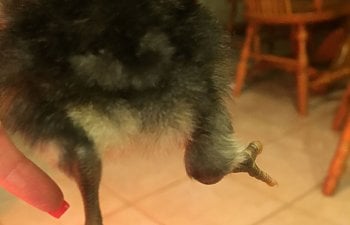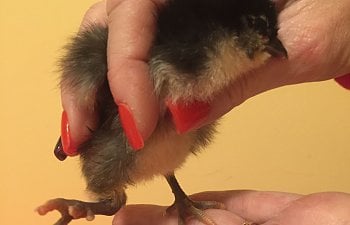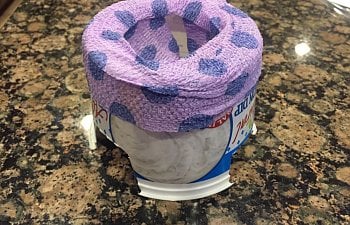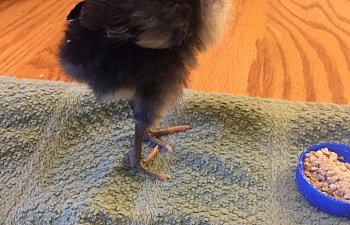On my most recent hatch this fall I had a problem with one of my new chicks. As I only had been hatching chicks for a short time I was not completely familiar with the disability that this chick was displaying. The symptoms were a flat hock, unable to extend the leg, unable to stand on the leg, walking on the knee, and swelling to the knee. The day the chick hatched I did not notice any problems as he was sleeping a lot just like all of the other chicks, and he was getting himself to the food and water dish just fine. The day after he hatched is when I noticed the symptoms.
He did not appear to be in any pain. I was able to move the leg, palpate the leg and the joint and he did not seem to mind. When I straightened the leg behind him (similar when chicks stand and stretch their legs) the joint seemed to look more normal, however there was still a decent amount of swelling. At this point I was certain that the chick had a slipped tendon.
From what I read I knew that this was a disability that needed to be fixed sooner rather than later. The longer they sit untreated the less likely they are to be corrected. My fear was him walking on the hock, getting open sores that became infected, and developing sepsis. (Which by the way I did find an individual who made a foam boot that was velcroed to the leg to protect the hock. It did need to be washed and the hock washed and dried regularly but the chicken was a thriving adult. This is something else that could be considered if you are okay with having a special needs bird.)
To correct the leg I decided to use vet wrap. Vet wrap is ideal because it sticks to itself, but not to the chick. I tried to get 1" vet wrap but the smallest I could find was 2". I ended up cutting it down to approximately 3/4". I then wrapped the chick in a towel (covering his head) to keep him calm and still. I placed the bird on his belly and gently pulled the leg backward into that same position I described earlier, the stretching position. (In my research it was also suggested that if this position does not work to wrap the leg in whichever position the tendon appears to be in place, for example slightly bent).
Next I gently adjusted the tendon back over the knee and then wrapped it with the vet wrap. I wrapped the leg so the joint was snug but not so tight that circulation was cut off. I made sure that the chick could not bend the knee but when I touched to toes the chick still responded. Chicks at this age grow VERY quickly so it is important to recheck the toes OFTEN to make sure that circulation is still intact (look for discoloration - blueness or a darkening of the tissue that does not match the other foot, cool or cold toes, toes that start to curl into a fist, chick does not respond when touching the foot - all of these are signs that circulation is being cut off. If circulation is being cut off then the wrap is too tight and needs to be redone.)
After I wrapped the leg, I made a "sling chair" with vet wrap and a rubbermaid container. Now, the chick DID NOT like the sling chair, but I strapped him in and secured him with vet wrap. His feet were dangling and I did not allow them to touch the ground. It is important that the chick not bare weight on the bad leg until it heals. I was aware that the pressure points that the chick was now laying on could cause bedsores. With that said, I took him out of the chair every time I fed him to rub his belly and stretch his other leg. I also spent a lot of time holding this chick. He seemed much more calm and relaxed while I was holding him than when he was in the chair. But I do have 4 kids and 2 jobs so that was not always a possibility. I also found that when he was stressing out, if I put him in a dark quiet place he would generally go to sleep. (Keep in mind that since this chick cannot move you must be very aware of how hot the chick is getting under the brooder light. He is not able to move to go cool off if he is getting too hot. You don't want to save the chick's leg only to lose your chick to heat exhaustion!)
I was offering food and water every 2 hours. Taping small food and water containers to the side of the chair entered my mind, but I knew the chick still needed to be taken out regularly to readjust his position and stretch. I was giving the chick Poli-Vi-Sol 1 drop 3 times a day and Pedialite. I was not sure if the chick was getting enough nutrition and also found that the slipped tendon could be a vitamin deficiency issue. Even though I normally feed medicated chick starter feed, I fed the chick NONmedicated food during his recovering. I did this so that that the feed would not interfere with the vitamin absorption.
About 31 hours after I placed to leg wrap I had noticed that the chick's toes were darker than the other foot. The chick did still move the toes a little but they also felt slightly cooler (all signs that the circulation was being affected... with the chick growing so fast the wrap had become tight very quickly). I started to unwrap the leg to readjust the wrap. Again this little chick was not thrilled that I was messing with his leg, so again I wrapped him in a towel to cover the head. Vet wrap does stick to itself very well so I was careful not to pull too hard and hurt the hip or knee joints.
Once I unwrapped the chick's leg, the chick hopped up and tried to stand. Now because it had been wrapped straight for quite a while, when he stood the leg was straight - but at least he was off his hock. I left him there for a few minutes and he was slowly starting to flex the joint and in the right direction. At this point the chick was VERY WOBBLY and I did attempt to get him back in the sling chair without the wrap but he was not having it. I placed him back in a dark room and he ended up going to sleep. I continued to monitor him every few hours to make sure the tendon did not slip back out. Within 2 days he was completely stable on his leg and walking normally. I also continued with the Poli and Pedialite for another week.
The biggest lesson I learned here is to act promptly, give vitamins, and be patient. This was a success story and I believe that this chick will go on to lead a very full life. However I have also read lots of other stories where the tendon could not be fixed and the chick/chicken was put down. Others that could not be fixed applied the foam boot to the chicken's leg. Had I not been able to fix the tendon I believe this is what I would have done. I think each case is different and you need to go with your gut. The disability can be caused by vitamin deficiency, injury, and/or genetics. While I will keep this chick, I do not plan on having him being part of my breeding stock. Because I cannot be sure why the chick had this issue I do not want to take the chance of passing it to the next generation.
The first two pictures below are the chick prior to treatment.


This is the sling chair made with vet wrap.
This is the little black chick the day after the vet wrap was removed, walking normally.
He did not appear to be in any pain. I was able to move the leg, palpate the leg and the joint and he did not seem to mind. When I straightened the leg behind him (similar when chicks stand and stretch their legs) the joint seemed to look more normal, however there was still a decent amount of swelling. At this point I was certain that the chick had a slipped tendon.
From what I read I knew that this was a disability that needed to be fixed sooner rather than later. The longer they sit untreated the less likely they are to be corrected. My fear was him walking on the hock, getting open sores that became infected, and developing sepsis. (Which by the way I did find an individual who made a foam boot that was velcroed to the leg to protect the hock. It did need to be washed and the hock washed and dried regularly but the chicken was a thriving adult. This is something else that could be considered if you are okay with having a special needs bird.)
To correct the leg I decided to use vet wrap. Vet wrap is ideal because it sticks to itself, but not to the chick. I tried to get 1" vet wrap but the smallest I could find was 2". I ended up cutting it down to approximately 3/4". I then wrapped the chick in a towel (covering his head) to keep him calm and still. I placed the bird on his belly and gently pulled the leg backward into that same position I described earlier, the stretching position. (In my research it was also suggested that if this position does not work to wrap the leg in whichever position the tendon appears to be in place, for example slightly bent).
Next I gently adjusted the tendon back over the knee and then wrapped it with the vet wrap. I wrapped the leg so the joint was snug but not so tight that circulation was cut off. I made sure that the chick could not bend the knee but when I touched to toes the chick still responded. Chicks at this age grow VERY quickly so it is important to recheck the toes OFTEN to make sure that circulation is still intact (look for discoloration - blueness or a darkening of the tissue that does not match the other foot, cool or cold toes, toes that start to curl into a fist, chick does not respond when touching the foot - all of these are signs that circulation is being cut off. If circulation is being cut off then the wrap is too tight and needs to be redone.)
After I wrapped the leg, I made a "sling chair" with vet wrap and a rubbermaid container. Now, the chick DID NOT like the sling chair, but I strapped him in and secured him with vet wrap. His feet were dangling and I did not allow them to touch the ground. It is important that the chick not bare weight on the bad leg until it heals. I was aware that the pressure points that the chick was now laying on could cause bedsores. With that said, I took him out of the chair every time I fed him to rub his belly and stretch his other leg. I also spent a lot of time holding this chick. He seemed much more calm and relaxed while I was holding him than when he was in the chair. But I do have 4 kids and 2 jobs so that was not always a possibility. I also found that when he was stressing out, if I put him in a dark quiet place he would generally go to sleep. (Keep in mind that since this chick cannot move you must be very aware of how hot the chick is getting under the brooder light. He is not able to move to go cool off if he is getting too hot. You don't want to save the chick's leg only to lose your chick to heat exhaustion!)
I was offering food and water every 2 hours. Taping small food and water containers to the side of the chair entered my mind, but I knew the chick still needed to be taken out regularly to readjust his position and stretch. I was giving the chick Poli-Vi-Sol 1 drop 3 times a day and Pedialite. I was not sure if the chick was getting enough nutrition and also found that the slipped tendon could be a vitamin deficiency issue. Even though I normally feed medicated chick starter feed, I fed the chick NONmedicated food during his recovering. I did this so that that the feed would not interfere with the vitamin absorption.
About 31 hours after I placed to leg wrap I had noticed that the chick's toes were darker than the other foot. The chick did still move the toes a little but they also felt slightly cooler (all signs that the circulation was being affected... with the chick growing so fast the wrap had become tight very quickly). I started to unwrap the leg to readjust the wrap. Again this little chick was not thrilled that I was messing with his leg, so again I wrapped him in a towel to cover the head. Vet wrap does stick to itself very well so I was careful not to pull too hard and hurt the hip or knee joints.
Once I unwrapped the chick's leg, the chick hopped up and tried to stand. Now because it had been wrapped straight for quite a while, when he stood the leg was straight - but at least he was off his hock. I left him there for a few minutes and he was slowly starting to flex the joint and in the right direction. At this point the chick was VERY WOBBLY and I did attempt to get him back in the sling chair without the wrap but he was not having it. I placed him back in a dark room and he ended up going to sleep. I continued to monitor him every few hours to make sure the tendon did not slip back out. Within 2 days he was completely stable on his leg and walking normally. I also continued with the Poli and Pedialite for another week.
The biggest lesson I learned here is to act promptly, give vitamins, and be patient. This was a success story and I believe that this chick will go on to lead a very full life. However I have also read lots of other stories where the tendon could not be fixed and the chick/chicken was put down. Others that could not be fixed applied the foam boot to the chicken's leg. Had I not been able to fix the tendon I believe this is what I would have done. I think each case is different and you need to go with your gut. The disability can be caused by vitamin deficiency, injury, and/or genetics. While I will keep this chick, I do not plan on having him being part of my breeding stock. Because I cannot be sure why the chick had this issue I do not want to take the chance of passing it to the next generation.
The first two pictures below are the chick prior to treatment.
This is the sling chair made with vet wrap.
This is the little black chick the day after the vet wrap was removed, walking normally.





